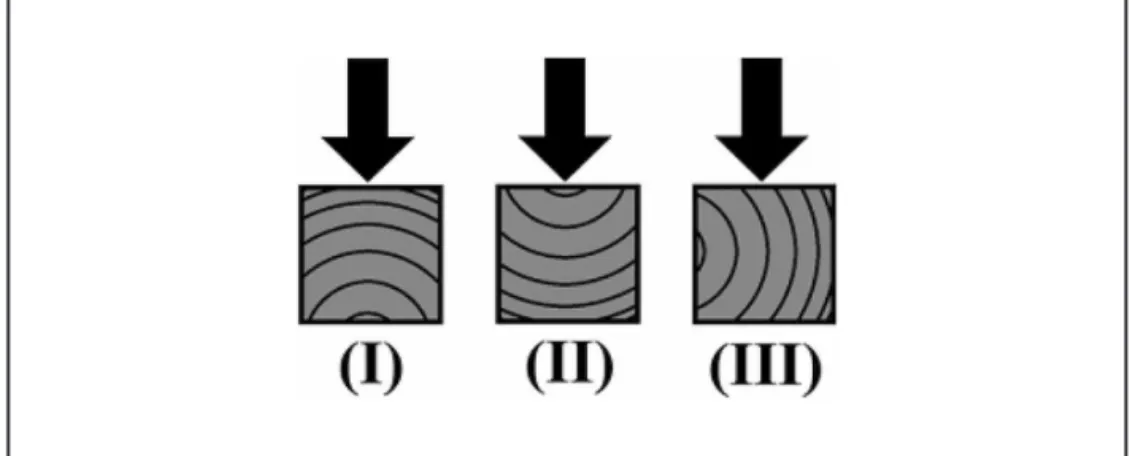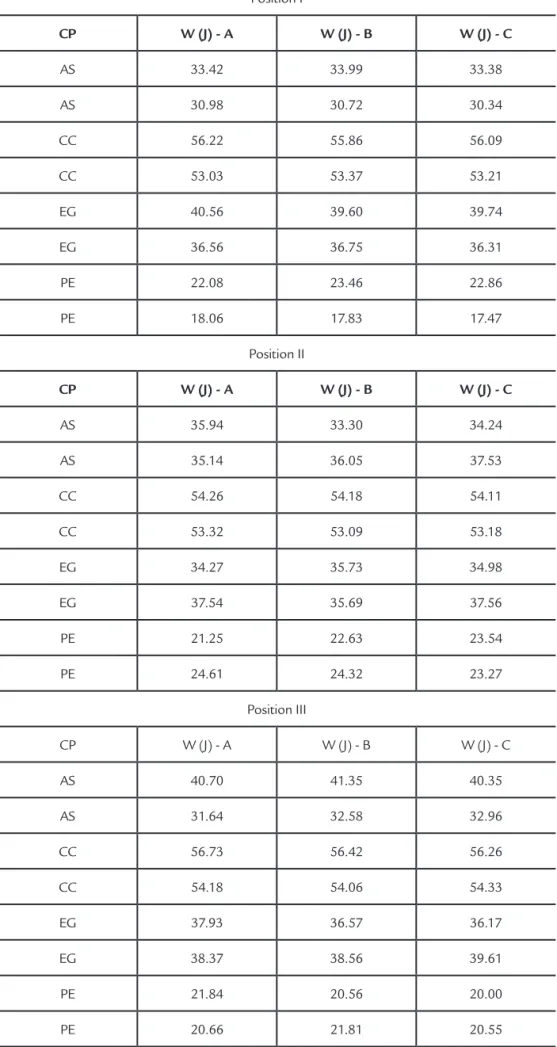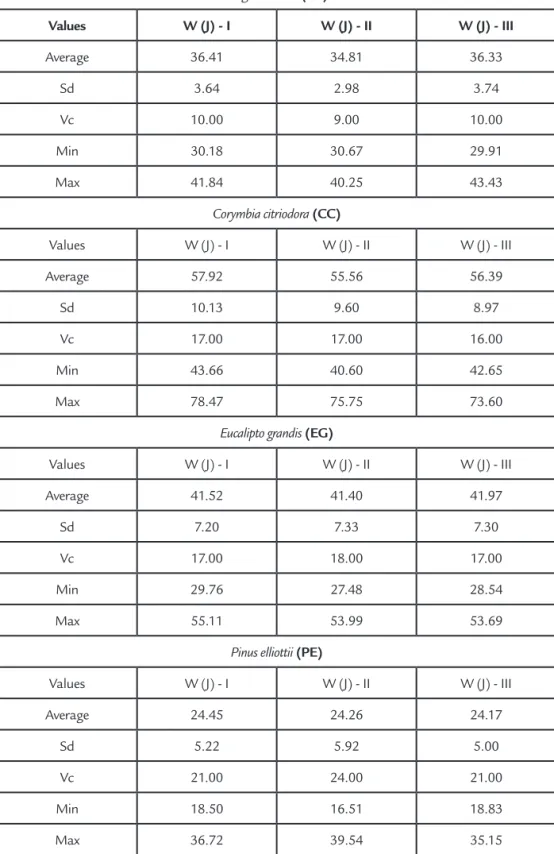Abstract
Wood toughness is a mechanical property of interest in structural design where the load impact must be considered, inding a strong application in bridges, however, not an integral part of the mechanical properties commonly investigated in the characterization of this material. This study aimed to investigate with the aid of variance analysis, the inluence of growth ring orientation to obtain toughness for Angelim Saia (Parkia pendula), Eucalyptus grandis, Pinus elliottii and Cor-ymbia citriodora wood species, considering three different positions, so that the orientation causes tensile strength in ibers near the pitch, near the bark, and in the radial direction. The results of the statistical analysis revealed that there was no sig-niicance in the orientation of the growth rings to obtain the toughness of the wood species investigated, where the highest values were for Corymbia citriodora and the least values were for Pinus elliottii.
Keywords: Toughness, wood species, growth ring.
Influence of growth ring
orientation of some wood
species to obtain toughness
Denise Ortigosa StolfProfessor PhD
FAEM College Education Unit Center Chapecó - Santa Catarina – Brazil destolf@yahoo.com.br
Marilia Silva Bertolini Post-doctoral researcher University of São Paulo
Department of Structural Engineering São Carlos – São Paulo – Brazil marilia.bertolini@usp.br
Diego Henrique Almeida Master in Structural Engineering University of São Paulo
Department of Structural Engineering São Carlos – São Paulo – Brazil diegoestruturas@gmail.com
Diogo Aparecido Lopes Silva PhD student
University of São Paulo
Department of Production Engineering São Carlos – São Paulo – Brazil diogo.apls@hotmail.com
Túlio Hallak Panzera Associate Professor
Federal University of São João Del-Rei (UFSJ), Centre For Innovation and
Technology in Composites (CITeC) São João D’El Rei – Minas Gerais – Brazil panzera@ufsj.edu.br
André Luis Christóforo Adjunct Professor
Federal University of São Carlos Department of Civil Engineering (DECiv) São Carlos – São Paulo – Brazil christoforoal@yahoo.com.br
Francisco Antônio Rocco Lahr Full Professor
University of São Paulo
Department of Structural Engineering São Carlos – São Paulo – Brazil frocco@sc.usp.br
Civil Engineering
Engenharia Civil
2. Material and Methods
The toughness tests were per-formed at the Wood and Timber Structures Laboratory, Department of Structural Engineering, São Car-los School of Engineering, University of São Paulo (LaMEM/SET/EESC/ USP) using the Charpy Pendulum test. Tests were performed in equipment developed by Siqueira (1986), based on machine type FPL (developed by Forest Products Laboratory - USA) using a modiied Charpy pendulum. The principle of operation is charac-terized by kinetic energy provided by the pendulum via a lexible current, with a support at its end. Rupture of
the specimen is obtained by a single movement of pendulum. Calculations for determination of toughness were performed according to ASTM D143-52 (ASTM 1981).
The woods of Angelim Saia -
Parkia pendula (AS) came from the northeastern state of Mato Grosso, and Eucaliptus grandis (EG), Pinus elliottii (PE) and Corymbia citriodora
(CC) from the Itirapina city (SP). With the aid of a greenhouse, the specimens of the four species had their moisture content adjusted to 12%, according to the premiss of the Brazilian standard ABNT NBR 7190 (1997), using 8
spec-imens for each wood species evaluated. The Angelim Saia wood attained an average density of 0.72 g/cm3, while for
the Corymbia citriodora, Eucalyptus grandis and Pinus elliottii woods, the densities were 0.96 g/cm3, 0.62 g/cm3
and 0.54 g/cm3, respectively.
The specimens for toughness testing (2×2×28cm) were extracted from three pieces of lumber with di-mensions of 2×2×100cm. The three specimens (per piece) gave origin to three distinct orientations of growth rings in relation to the direction of impact strength, as illustrated in Figure 1.
Wood has long been used by man throughout history, being directly related to the solution of problems such as dwellings; crossing natural or artiicial obstacles; manufacturing of vehicles for different types of transport; storage and transport of agricultural products; manufacturing of furniture, and others (ROCCO LAHR, CALIL JR. e DIAS, 2003).
Knowledge of the physical and mechanical properties of wood allows for its better use (FIORELLI e DIAS,
2011; CARREIRA et al. 2012;
MO-LINA et al. 2012; CHRISTOFORO,
2013). By reason of the dificulties in performing tests for the characteriza-tion of the species, wood is often used without the essential knowledge of its properties, thus leading to material waste (STOLF, 2000).
Special importance is given to the study of wood in relation to its perfor-mance when applied to loads that cause impact, particularly in the applications mentioned above, according to Souza et al. (2009), motivating the development of research on this topic.
Pazos et al. (2003) investigated the toughness and impact strength of wood
Lysiloma bahamensis, with density of 0.62 g/cm³, under 12% of moisture content and saturated conditions. The values of toughness or absorbed work (W) obtained from saturated and dry woods were equal to 41.75J and 46.75J, respectively. Among others, the authors concluded that the saturated wood presented the highest toughness and
impact strength.
Stangerlin et al. (2008a) developed
research on wood of the Eucalyptus
dunnii specie in order to investigate the effect of the orientation of the iber (radial and tangential) to obtain the toughness and impact strength. Further-more, the authors concluded that the positioning in the radial direction pro-vided higher values of impact strength and toughness when compared to those obtained from specimens positioned in the tangential direction. The same au-thors, in another study (Stangerlin et al.
2008b) studied the impact strength of
Eucalyptus botryoides and Eucalyptus saligna wood species. The authors con-cluded that it isn’t possible to estimate the toughness of the wood through the bulk density.
Beltrame et al. (2012) researched the effect of moisture content (12% and saturated) in the impact strength of
nogueira-pecã wood (Carya
illinoinen-sis), from two physiographic regions of the Rio Grande do Sul state. Specimens were also prepared and tested for impact strength directions, radial and tangen-tial positions and withdrawal, near the spinal cord and the next shell. As for the energy absorbed or toughness, saturated specimens showed higher (7.774 kg·m) compared the toughness of woods with 12% of moisture content (2.976 kg·m), about 161% higher on average.
Almeida et al. (2014) evaluated in their studies the possibility to estimate the toughness with the knowledge of the apparent density of 6 Brazilian tropical
wooden species (Angico, Eucalyptus, Jatobá, Paricá, Pine and Teak), by using linear, quadratic and cubic polynomial regression models. The cubic polynomi-al was the most eficient for estimating the wood toughness, with R² = 84.70%.
In addition to moisture content and density, the orientation of growth rings can be inluential on the wooden toughness. According to Smith, Lands and Gong (2003), observations at fracture at micro scale indicated that wall thickness has a stronger inluence on the fracture of individuals cells than cells size. Fracture in low density wood is usually transwall, while for higher density wood both transwall and intercellular fracture is observed. Consequently, there are different frac-ture modes in earlywood and latewood cells. Intercellular fracture is observed in thick-walled latewood cells, while transwall fracture is observed in thin-walled earlywood cells. In this sence, the proportion of earlywood to late-wood will affect bulk fracture tough-ness measurements.
In order to generate subsidies to expand the knowledge about the behavior of wood when requested by impact loads, this study aimed to investigate the inluence of the orien-tation of the growth rings in obtain-ing toughness in the woods: Angelim
Saia (Parkia pendula), Eucalyptus
grandis, Pinus elliottii and Corymbia citriodora, using analysis of variance (ANOVA) in order to investigate the possible differences.
Figure 1 Positioning of growth rings for toughness evaluation of the woods.
From Figure 1, the impact strength was directed to cause tensile strength in the ibers closest to the core (Position I), in the ibers closer to the shell (position II) and in the radial direction (Position III). In order to ensure that all possible tough-ness variability results come from only the orientation of the growth rings, the inlu-ence of the longitudinal extract position (A; B; C) of the specimens of bars 100 cm long (Figure 2) was evaluated, for
obtain-ing the toughness. It should be noted that the samples to obtain the toughness were extracted from wooden beams and not directly from trees. In this sense, only the position of extraction samples in relation to the longitudinal direction of beams was addressed. For this, we used two pieces of dimensions 2× 2×100 cm per wood spe-cies (AS; CC; EG; PE) and shape orienta-tion of growth rings. The inluence of the specimen’s extraction position to determine
toughness was determined with variance analysis (ANOVA), whose basis was the nonparametric Kruskal-Wallis test, at a signiicance level of 5%, considering equiva-lence between means as null hypothesis (H0) and the non-equivalence between means as alternative hypothesis (H1). P-value of the test greater than the signiicance level implies acceptance of H0, otherwise, it is rejected. Statistical analyzes were made by Minitab 16 software.
Figure 2 Position of extraction of specimens.
Once the independence of the extraction position of the specimens was proven, the variance analysis was employed again to investigate the inlu-ence of the guidelines of the growth rings in obtaining toughness. Thus, 13 pieces of Angelim Saia, 20 pieces
of Corymbia citriodora, 32 pieces of
Eucalyptus grandis and 35 pieces of
Pinus elliottii wood species, measuring 2×2×100 cm were prepared. From each piece, three specimens (2×2×28 cm) were extracted, oriented in the three positions shown in Figure 1, providing
39 toughness tests for Angelim Saia
wood (13 per position), 60 for
Corym-bia citriodora wood (20 per position), 96 for Eucalyptus grandis wood (32 per position) and 105 for the Pinus el-liottii wood (35 per position), totaling 300 tests.
3. Results and Discussion
Table 1 shows the results for the toughness obtained according to the
ex-traction position (A, B, C) of the specimen (CP) along the length of 100 cm pieces for
Position I
CP W (J) - A W (J) - B W (J) - C
AS 33.42 33.99 33.38
AS 30.98 30.72 30.34
CC 56.22 55.86 56.09
CC 53.03 53.37 53.21
EG 40.56 39.60 39.74
EG 36.56 36.75 36.31
PE 22.08 23.46 22.86
PE 18.06 17.83 17.47
Position II
CP W (J) - A W (J) - B W (J) - C
AS 35.94 33.30 34.24
AS 35.14 36.05 37.53
CC 54.26 54.18 54.11
CC 53.32 53.09 53.18
EG 34.27 35.73 34.98
EG 37.54 35.69 37.56
PE 21.25 22.63 23.54
PE 24.61 24.32 23.27
Position III
CP W (J) - A W (J) - B W (J) - C
AS 40.70 41.35 40.35
AS 31.64 32.58 32.96
CC 56.73 56.42 56.26
CC 54.18 54.06 54.33
EG 37.93 36.57 36.17
EG 38.37 38.56 39.61
PE 21.84 20.56 20.00
PE 20.66 21.81 20.55
Table 1
Toughness obtained from
specimens extracted along the bars.
Table 2 presents the results of the variance analysis for nonparametric Kruskal-Wallis toughness tests of the woods for tree orientations of the
growth rings. As the P-values found are both higher than the signiicance level of the test (5%), the null hypothesis should be accepted, implying no signiicant
Table 2 Results of the Kruskal-Wallis test
processed with ANOVA for the extraction position of the specimen on the wooden toughness.
Orientation H DF P-value
I 0.0600 2 0.9704
II 0.0650 2 0.9680
III 0.0650 2 0.9680
Table 3 presents the results of the wood toughness (W) obtained as a function of the orientation of the
growth rings, average is the sample mean, Sd is the standard deviation, Vc is the variation coeficient, and Min
and Max are the smallest and largest values found.
Angelim Saia (AS)
Values W (J) - I W (J) - II W (J) - III
Average 36.41 34.81 36.33
Sd 3.64 2.98 3.74
Vc 10.00 9.00 10.00
Min 30.18 30.67 29.91
Max 41.84 40.25 43.43
Corymbia citriodora(CC)
Values W (J) - I W (J) - II W (J) - III
Average 57.92 55.56 56.39
Sd 10.13 9.60 8.97
Vc 17.00 17.00 16.00
Min 43.66 40.60 42.65
Max 78.47 75.75 73.60
Eucalipto grandis(EG)
Values W (J) - I W (J) - II W (J) - III
Average 41.52 41.40 41.97
Sd 7.20 7.33 7.30
Vc 17.00 18.00 17.00
Min 29.76 27.48 28.54
Max 55.11 53.99 53.69
Pinus elliottii(PE)
Values W (J) - I W (J) - II W (J) - III
Average 24.45 24.26 24.17
Sd 5.22 5.92 5.00
Vc 21.00 24.00 21.00
Min 18.50 16.51 18.83
Max 36.72 39.54 35.15
Table 3 Results of the wood toughness (W) in joules (J) in terms of growth rings.
The lowest toughness values came from the Pinus elliottii wood species,
meanwhile, the lowest density, and highest toughness values came from the
Table 4
Results of the Kruskal-Wallis ANOVA factor orientation of growth rings in obtaining wood toughness.
Species H DF P-value
Angelim Saia 2.3588 2 0.3075
Corymbia citriodora 0.4528 2 0.7974
Eucaliptus grandis 0.2418 2 0.8982
Pinus elliottii 0.1087 2 0.9471
By P-values found in Table 4 were above the signiicance level for both spe-cies, the null hypothesis was accepted, implying no signiicance in the growth
ring orientation for obtaining the tough-ness of the woods investigated; different from the results presented by Stangerlin et al. (2008b), which stated that the impact
strength and toughness of Eucalyptus
dunnii in the radial direction was greater than the impact strength and toughness in the tangential direction.
4. Conclusion
The results of the toughness for the four wood species evaluated showed no signiicance in growth ring orienta-tion and the Pinus elliottii and Corym-bia citriodora wood species showed the
lowest and highest values respectively, emphasizing that these also had the largest and lowest wood densities.
In general, the results of this research contribute to a better
under-standing of the performance of the woods here investigated when under the impacts upon requested.
5. References
ALMEIDA, D. H., SCALIANTE, R. M., CHRISTOFORO, A. L., VARANDA, L. D., ROCCO LAHR, F. A., DIAS, A. A., CALIL JÚNIOR, C. Tenacidade da ma-deira como função da densidade aparente. Revista Árvore, v.38, n.1, p. 203-207, 2014.
AMERICAN SOCIETY FOR TESTING AND MATERIALS. ASTM D143-52: Standard methods of testing small clear specimens of timber. Philadelphia, 1981. ASSOCIAÇÃO BRASILEIRA DE NORMAS TÉCNICAS. ABNT NBR 7190:
Proje-to de estruturas de madeiras. Rio de Janeiro, 1997.
BELTRAME, R., MATTOS, B. D., GATTO, D. A., LAZAROTTO, M., HASE-LEIN, C. R., SANTINI, E. J. Resistência ao impacto da madeira de nogueira-pecã em diferentes condições de umidade. Ciência Rural, v.42, n.9, 2012.
CARREIRA, M. R., SEGUNDINHO, P. G. A., ROCCO LAHR, F. A., DIAS, A. A., CALIL JR., C. Bending stiffness evaluation of Teca and Guajará lumber through tests of transverse and longitudinal vibration. Acta Scientiarum. Technology (Im-presso), v. 34, p. 27-32, 2012.
CHRISTOFORO, A. L., RIBEIRO FILHO, S. L. M., PANZERA, T. H., ROCCO, F. A. L. Metodologia para o cálculo dos módulos de elasticidade longitudinal e transversal em vigas de madeira de dimensões estruturais. Ciência Rural (UFSM. Impresso), v. 43, p. 610, 2013.
FIORELLI, J., DIAS, A. A. Glulam beams reinstrengthd with FRP externally-bonded: theoretical and experimental evaluation. Materials and Structures, v. 44, p. 1431-1440, 2011.
MOLINA, J. C., CALIL JR, C., KIMURA, E. F. A., PINTO, E. M., REGOBELLO, R, SCHEER, M. B., CARNEIRO, C., BRESSAN, O. A., SANTOS, K. G. Análise numérica do comportamento de elementos de madeira em situação de incêndio.
Floresta e Ambiente, v. 19, p. 162-170, 2012.
PAZOS, G. B., MORALES, R. P. Z., CANDELARIA, V. R. O. Correlación de los re-sultados de impacto o tenacidad de 16 maderas mexicanas utilizando dos métodos de prueba. Revista Madera y Bosques, v. 9, n. 1, p. 55-70, 2003.
ROCCO LAHR, F. A., CALIL JR, C., DIAS, A. A. Dimensionamento de elementos
estruturais de madeira. Rio de janeiro: Manole Ltda, 2003. 152 p. those evaluated.
Just as other wood species used in research developed by Pazos et al. (2003), Stangerlin et al. (2008a), Beltrame et al.
(2010) and Beltrame et al. (2012), the
toughness values were close to those obtained from the present study.
Table 4 presents the Kruskal-Wal-lis/ANOVA results for the orientation of growth rings (I, II, III) on the toughness
SIQUEIRA, M. L. Projeto e construção de máquina para determinação da tenaci-dade de madeira. São Carlos: Escola de Engenharia de São Paulo, Universidade de São Paulo, 1986. 103p. (Dissertação Mestrado).
SMITH, I., LANDS, E., GONG, M. Fracture and fatigue in wood. Chichester:
Wil-ley, 2003.
SOUZA, J. T., MACHADO, W. G., BELTRAME, R., MODES, K. S., VIVIAN, M. A., HASELEIN, C. R. Estudo do comportamento da lexão dinâmica em fun-ção da massa especíica da madeira de Araucaria angustifolia (Bertol.) Kuntze. In: CONGRESSO DE INICIAÇÃO CIENTÍFICA (CIC), 28, ENCONTRO DE PÓS-GRADUAÇÃO (ENPOS), 11, MOSTRA CIENTÍFICA, 1. Anais... Pelotas: Universidade Federal de Pelotas, 2009, 5 p. (CD ROM).
STANGERLIN, D. M., MELO, R. R., DOMINGUES, J. M. X. Determinação da re-sistência ao impacto para as madeiras de Eucalyptus dunnii, Corymbia citriodora e Pouteria pachycarpa. In: ENCONTRO BRASILEIRO EM MADEIRA E ESTRU-TURAS DE MADEIRA, 11. Anais... Londrina: 2008a. (CD ROM).
STANGERLIN, D. M., GATTO, D. A., DOMINGUES, J. M. X., CALEGARI, L., MULLER, M. T. Avaliação da resistência ao impacto para as madeiras de Eucalyp-tus botrioides e EucalypEucalyp-tus saligna. In: CONGRESSO FLORESTAL ESTADUAL, 10. Anais... Nova Prata, RS: 2008b. (CD ROM).
STOLF, D. O. Tenacidade da madeira. São Carlos: Escola de Engenharia de São Car-los, Universidade de São Paulo, 2000. 101 p. ( Dissertação de Mestrado em Ciência e Engenharia de Materiais).


